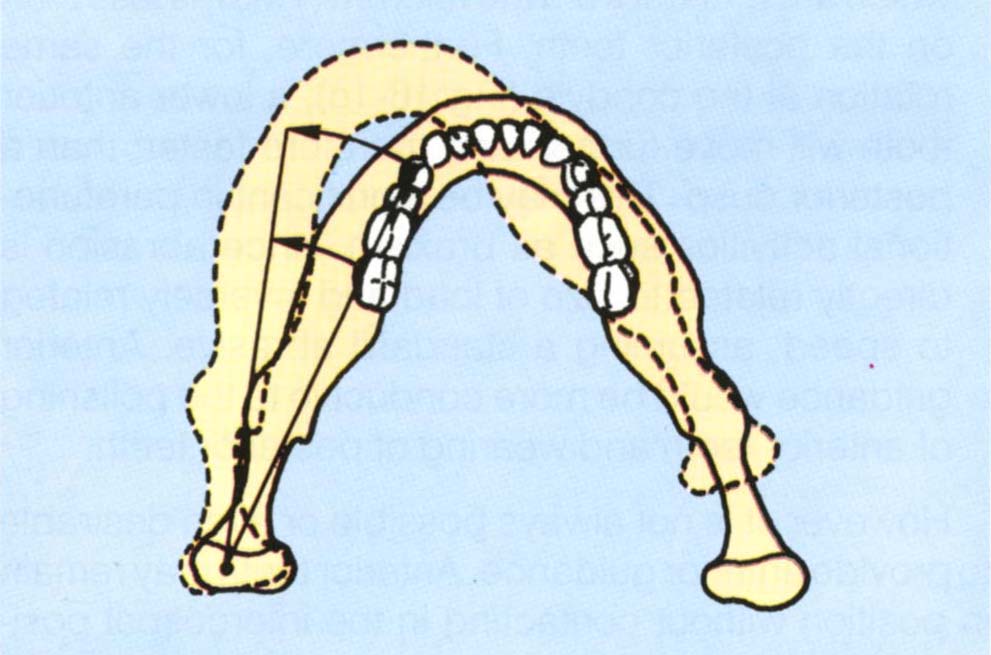Chapter 16
RESTORATION OF ANTERIOR TEETH
It is important to understand the effect on mandibular movement of contacting surfaces of anterior teeth (anterior guidance) before such teeth are restored (Figs 16-1a–b). The term ‘anterior guidance’ may be used to describe the effects on mandibular movement of any tooth guidance, as opposed to posterior or condylar guidance. In this text, however, the term ‘anterior guidance’ will be used to denote the effect on mandibular movement of contacting surfaces of anterior teeth. Restorations with a shallow anterior guidance may result in:
- Interference between opposing posterior cusps.
- Poor aesthetics.
- Mechanical failure of anterior restorations.
- Patient discomfort.
Fig. 16-1 Anterior guidance.

Fig. 16-1a/b Sagittal plane diagrams (condyles are shaded) showing protrusive movement (arrow); (a) Steep anterior guidance; (b) Shallow anterior guidance with the same condylar guidance as (a). Note the reduced clearance between the posterior teeth during protrusion, leading to the clashing of cusps.

Fig. 16-1c For the same rotation of the condyle, the canine moves further and, therefore, faster than the molar (assuming there is no bodily movement).
At present there are few experimental data to assist the dentist in the prescription of anterior guidance, but there are certain clinical guidelines which will now be discussed.1–6
When restoring anterior teeth, it must be decided whether or not to provide light contact between upper and lower incisors and canines in the intercuspal position. Light contact will facilitate anterior guidance, whereas spacing between the upper and lower anterior segments makes such guidance difficult to achieve. There are several mechanical advantages in providing anterior guidance for excursive movement:
- It is easier to make adjustments in the front of the mouth rather than the back.
- Unimpeded mandibular movement can be achieved without posterior teeth jarring.
- Elimination of lateral posterior contacts reduces the activity of the elevator muscles and hence reduces the risk of mechanical failure of restorations.7
- Heavy occlusal loading of individual teeth can be avoided in excursive movements, as it is easy to see and adjust the guidance surfaces.
- The stability of anterior teeth can be enhanced by repeated contacts.
- In excursive grinding movements, in the absence of bodily sideshift, the mandible and its muscles (especially the masseter) and the TM joints may conveniently be regarded as a third-order lever. Therefore, for a given effort, the load on the anterior teeth, which are furthest from the fulcrum (TMJ), is less than on the posterior teeth. Furthermore, for the same rotation at the condyle (Fig 16-1c), a lower anterior tooth will move further, and therefore faster, than a posterior cusp. This may be significant in parafunctional activities such as bruxism, since abrasion is directly related to size of load and inversely related to speed, assuming a standard abrasive. Anterior guidance would be more conducive to the polishing of anterior teeth and wearing of posterior teeth.
However, it is not always possible or even desirable to provide anterior guidance. Anterior teeth may remain in position without contacting in the intercuspal position, maintained by tongue, lip or occasional ‘functional’ tooth contacts. Problems may arise when the original guidance is changed by restorations. Suddenly changing a functional adaptive guidance may prove intolerable. On the other hand, where there are loose or drifting front teeth, or fracture or wear of anterior or posterior restorations, consideration must be given to the cause and to the possible need for alteration in anterior guidance.
If the anterior guidance must be changed, the requirements outlined in Chapter 10 should, if possible, be fulfilled. They may be summarized as follows:
Lateral Excursions
Working Side
- Patient comfort.
- Acceptable aesthetics and phonetics.
- Canine guidance or group function, or canine guidance with the facility to change into group function if wear or movement of the guidance teeth occurs.
- Guidance tooth or teeth to be mechanically sound, if possible, for example, not a tooth with an inadequate post.
- Unimpeded movement.
- Minimal deflection of the guidance tooth/teeth.
- No increasing mobility of the guidance tooth.
- No cementation failure of temporary restorations.
Non-Working Side
- Absence of contact.
It should be acknowledged that canine guidance cannot usually be built up to disclude the non-working side. Instead, the actual non-working side contacts must be reduced. Before doing so it should be verified that there are suitably positioned teeth on the working side to ‘pick up’ the guidance.
Protrusion and Latero-Protrusion
- Essentially the same as for lateral excursion.
- Aesthetics must not be spoiled.
- As many anterior teeth as possible should contact, as is reasonable, without compromising aesthetics or the gingivae – by making the crowns overbulbous, and, if possible, not just on an upper lateral incisor.
- Absence of posterior contact, although this may not be possible in Class III occlusions.
Single Anterior Crown
Providing there is no adverse history, the restoration should harmonize with the existing occlusion. If the restoration has fractured, the posterior occlusion should be examined. Post/>
Stay updated, free dental videos. Join our Telegram channel

VIDEdental - Online dental courses


